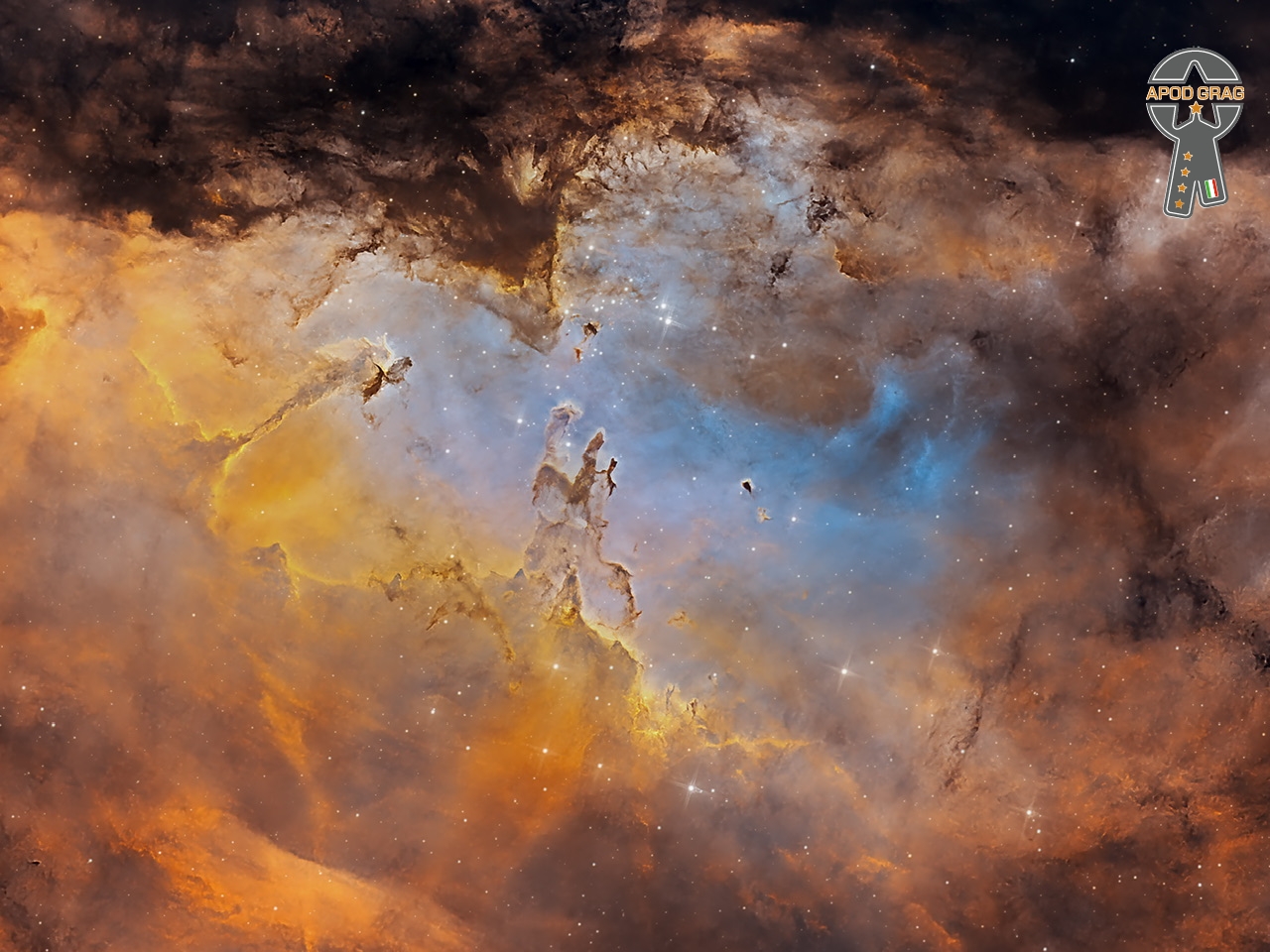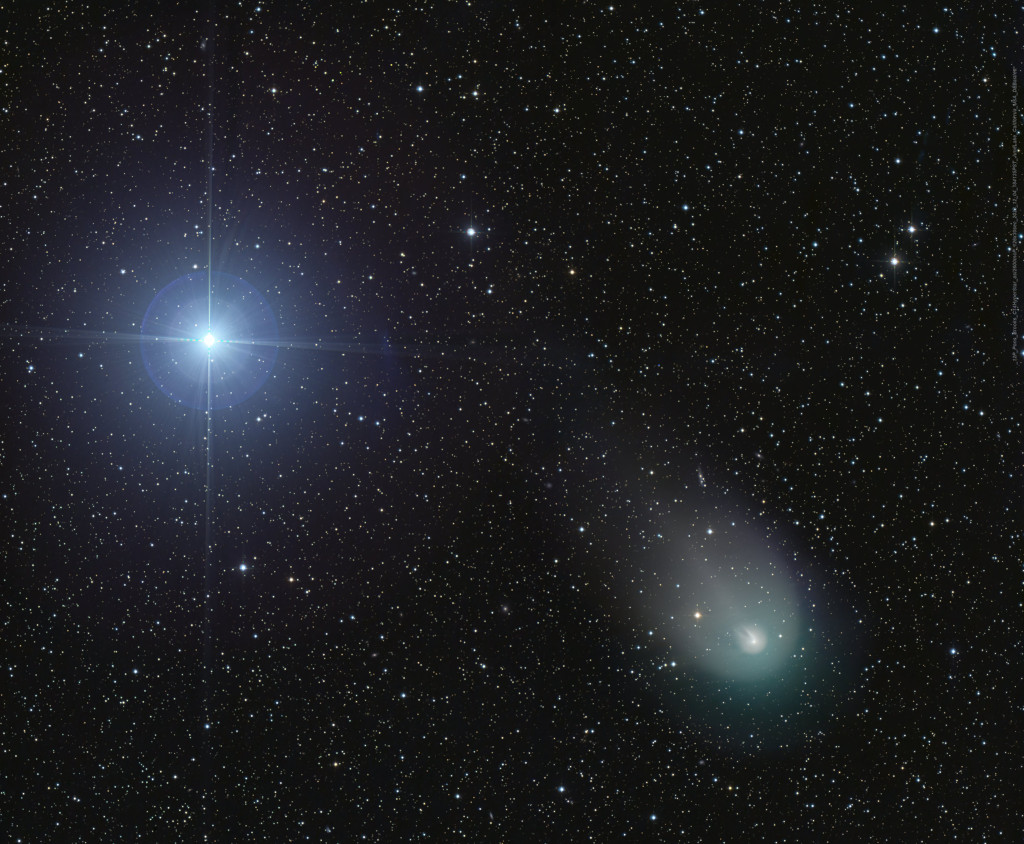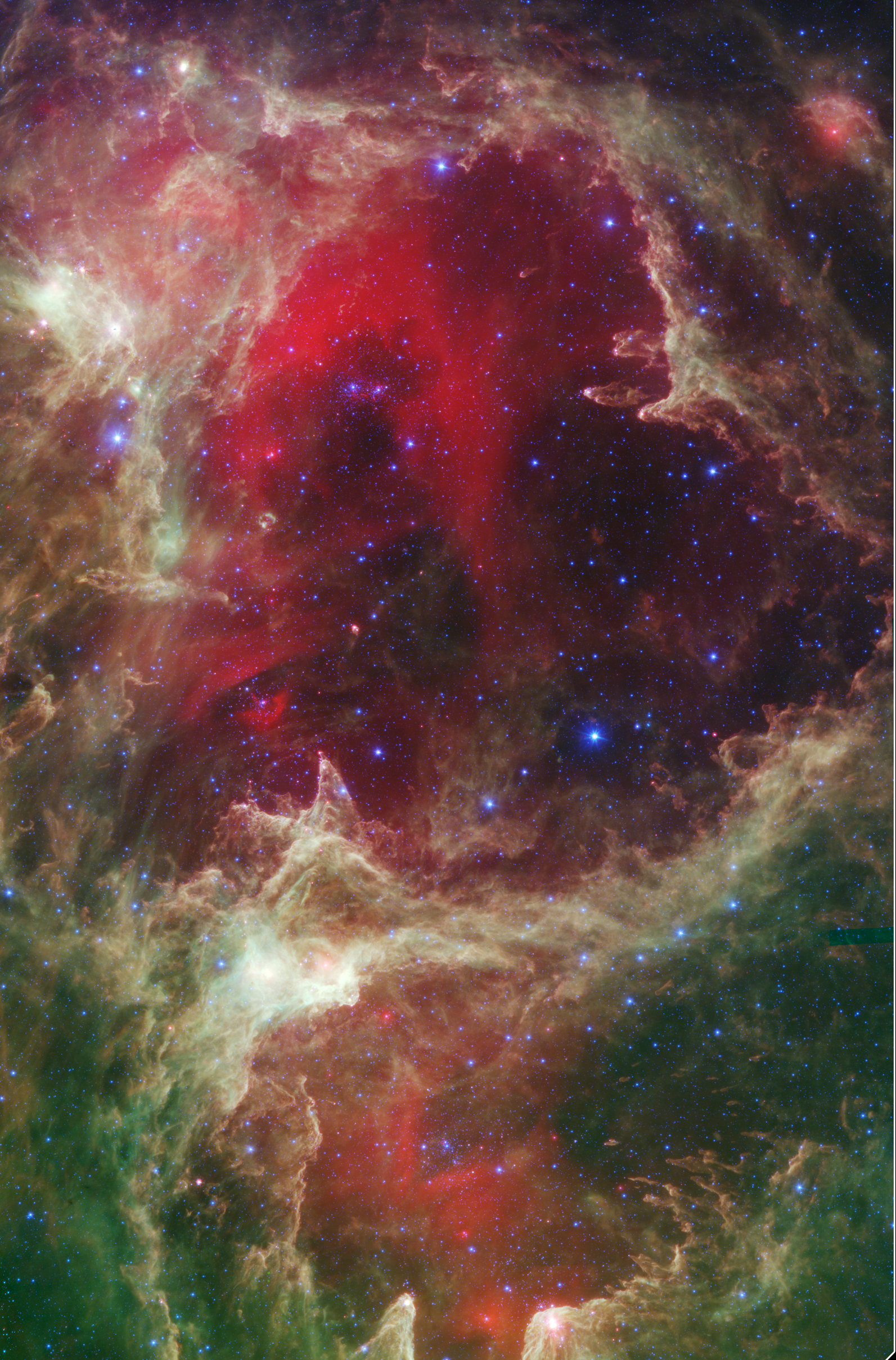Blog
Morton Gould (December 10, 1913 – February 21, 1996) was an American composer, conductor, arranger, and pianist.
Morton Gould was born in Richmond Hill, New York, United States. He was recognized early as a child prodigywith abilities in improvisation and composition. His first composition was published at age six. Gould studied at the Institute of Musical Art in New York. His most important teachers were Abby Whiteside and Vincent Jones.
During the Depression, Gould, while a teenager, worked in New York City playing piano in movie theaters, as well as with vaudeville acts. When Radio City Music Hall opened in December 1932, 19 year old Gould was hired as the staff pianist. By 1935, he was conducting and arranging orchestral programs for New York’s WOR radio station, where he reached a national audience via the Mutual Broadcasting System, combining popular programming with classical music.
more...M16 (Eagle Nebula), a diffuse emission nebula, with the iconic Pillars of Creation, a large region of star formation.
Stretching roughly 4 to 5 light-years, the Pillars of Creation are a fascinating but relatively small feature of the entire Eagle Nebula, which spans 70 by 55 light-years. The nebula, discovered in 1745 by the Swiss astronomer Jean-Philippe Loys de Chéseaux, is located 7,000 light-years from Earth in the constellation Serpens.

Daniel Ivan Hicks (December 9, 1941 – February 6, 2016) was an American singer-songwriter, musician, and the leader of Dan Hicks and His Hot Licks. His idiosyncratic style combined elements of cowboy folk, jazz, country, swing, bluegrass, pop, and gypsy music. He is perhaps best known for the songs “I Scare Myself” and “Canned Music”. His songs are frequently infused with humor, as evidenced by the title of his tune “How Can I Miss You When You Won’t Go Away?”. His album Live at Davies (2013) capped over forty years of music.
Writing about Hicks for Oxford American in 2007, critic David Smay said, “[T]here was a time from the ’20s through the ’40s when swing—’hot rhythm’—rippled through every form of popular music. That’s the music Dan Hicks plays, and there’s no single word for it because it wasn’t limited to any one genre. Django Reinhardt and the Mills Brothers and Spade Cooley and Hank Garland and the Boswell Sisters and Stuff Smith and Bing Crosby all swing. You can make yourself nutty trying to define what Dan Hicks is. Then again, you could just say: Dan Hicks swings.
more...Jessie Hill (December 9, 1932 – September 17, 1996) was an American R&B and Louisiana blues singer and songwriter, best remembered for the classic song “Ooh Poo Pah Doo“.
Hill was born in New Orleans, Louisiana, United States. By his teens he was playing drums in local bands, and in 1951 he formed his own group, the House Rockers. After periods performing as drummer with Professor Longhair and then Huey “Piano” Smith, Hill formed a new version of the House Rockers in 1958, which enabled him to focus on singing with the band. He is the grandfather of James and Troy Andrews.
The origins of “Ooh Poo Pah Doo” were apparently created from a tune played by a local pianist, who was known only as Big Four. Hill wrote the lyrics and melody, later expanding the work with an intro taken from Dave Bartholomew. It was further honed on stage, before Hill recorded a demo that he shopped to local record labels, finally recording a session at Cosimo Matassa‘s studio produced by Allen Toussaint.
more...Junior Wells (born Amos Wells Blakemore Jr.; December 9, 1934 – January 15, 1998) was an American singer, harmonica player, and recording artist. He is best known for his signature song “Messin’ with the Kid” and his 1965 album Hoodoo Man Blues, described by the critic Bill Dahl as “one of the truly classic blues albums of the 1960s”. Wells himself categorized his music as rhythm and blues.
Wells performed and recorded with various notable blues musicians, including Muddy Waters, Earl Hooker, and Buddy Guy. He remained a fixture on the blues scene throughout his career and also crossed over to rock audiences while touring with the Rolling Stones. Not long before Wells died, the blues historian Gerard Herzhaft called him “one of the rare active survivors of the ‘golden age of the blues'”.
Wells may have been born in Memphis, Tennessee, and raised in West Memphis, Arkansas (some sources report that he was born in West Memphis). Initially taught by his cousin Junior Parker and by Sonny Boy Williamson II, Wells learned to play the harmonica skillfully by the age of seven.
more...Donald Toussaint L’Ouverture Byrd II (December 9, 1932 – February 4, 2013) was an American jazz and rhythm & blues trumpeter and vocalist. A sideman for many other jazz musicians of his generation, Byrd was one of the few hard bop musicians who successfully explored funk and soul while remaining a jazz artist. As a bandleader, Byrd was an influence on the early career of Herbie Hancock and many others.
Byrd was born in 1932 in Detroit, Michigan. His family came from the African-American middle-class. His father, Elijah Thomas Byrd, was a Methodist minister who greatly valued education and oversaw his son’s schooling. His mother, Cornelia Taylor, introduced Byrd to jazz music and it was her brother who gave Byrd his first trumpet. He attended Cass Technical High School. He performed with Lionel Hampton before finishing high school. During this period, his first professional recording session was in 1949 at Fortune Records in Detroit with the Robert Barnes Sextette for the single “Black Eyed Peas” / “Bobbin’ At Barbee’s.” After playing in a military band during a term in the United States Air Force, Byrd obtained a bachelor’s degree in music from Wayne State University and a master’s degree from Manhattan School of Music. While still at the Manhattan School, he joined Art Blakey‘s Jazz Messengers as Clifford Brown’s successor. In 1955, he recorded with Gigi Gryce, Jackie McLean and Mal Waldron. After leaving the Jazz Messengers in 1956, he performed with many leading jazz musicians of the day, including John Coltrane, Sonny Rollins, Thelonious Monk, and later Herbie Hancock.
more...Performing for the Shabbat for the Soul service Friday December 8th at 630pm
more...On December 4, periodic Comet 12P/Pons-Brooks shared this telescopic field of view with Vega, alpha star of the northern constellation Lyra. Fifth brightest star in planet Earth’s night, Vega is some 25 light-years distant while the much fainter comet was about 21 light-minutes away. In recent months, outbursts have caused dramatic increases in brightness for Pons-Brooks though. Nicknamed the Devil Comet for its hornlike appearance, fans of interstellar spaceflight have also suggested the distorted shape of this comet’s large coma looks like the Millenium Falcon. A Halley-type comet, 12P/Pons-Brooks last visited the inner Solar System in 1954. Its next perihelion passage or closest approach to the Sun will be April 21, 2024. That’s just two weeks after the April 8 total solar eclipse path crosses North America. But, highly inclined to the Solar System’s ecliptic plane, the orbit of periodic Comet 12P/Pons-Brooks will never cross the orbit of planet Earth.

James Douglas Morrison (December 8, 1943 – July 3, 1971) was an American singer-songwriter and poetwho was the lead vocalist and lyricist of the rock band the Doors. Due to his energetic persona, poetic lyrics, distinctive voice, erratic and unpredictable performances, along with the dramatic circumstances surrounding his life and early death, Morrison is regarded by music critics and fans as one of the most influential frontmen in rock history. Since his death, his fame has endured as one of popular culture’s top rebellious and oft-displayed icons, representing the generation gap and youth counterculture.
Together with pianist Ray Manzarek, Morrison founded the Doors in 1965 in Venice, California. The group spent two years in obscurity until shooting to prominence with their number-one hit single in the United States, “Light My Fire“, taken from their self-titled debut album. Morrison recorded a total of six studio albums with the Doors, all of which sold well and many of which received critical acclaim. He was well known for improvising spoken word poetry passages while the band played live. Manzarek said Morrison “embodied hippie counterculture rebellion”.
Morrison developed an alcohol dependency throughout his life, which at times affected his performances on stage. In 1971, Morrison died unexpectedly in a Paris apartment at the age of 27, amid several conflicting witness reports. His untimely death is often linked with the 27 Club. Since no autopsy was performed, the cause of Morrison’s death remains disputed.
Although the Doors recorded two more albums after Morrison died, his death severely affected the band’s fortunes, and they split up two years later. In 1993, Morrison was inducted into the Rock and Roll Hall of Fame along with the other Doors members. Magazines including Rolling Stone, NME and Classic Rock, have ranked him among the greatest rock singers of all time.
more...James Oscar Smith (December 8, 1928 – February 8, 2005) was an American jazz musician whose albums often appeared on Billboard magazine charts. He helped popularize the Hammond B-3 organ, creating a link between jazz and 1960s soul music.
In 2005, Smith was awarded the NEA Jazz Masters Award from the National Endowment for the Arts, the highest honor that America bestows upon jazz musicians. There is confusion about Smith’s birth year, with sources citing either 1925 or 1928. Born James Oscar Smith in Norristown, Pennsylvania, he joined his father doing a song-and-dance routine in clubs at the age of six. He began teaching himself to play the piano. When he was nine, Smith won a Philadelphia radio talent contest as a boogie-woogie pianist. After a period in the U.S. Navy, he began furthering his musical education in 1948, with a year at Royal Hamilton College of Music, then the Leo Ornstein School of Music in Philadelphia in 1949. He began exploring the Hammond organ in 1951. From 1951 to 1954, he played piano, then organ in Philly R&B bands like Don Gardner and the Sonotones. He switched to organ permanently in 1954 after hearing Wild Bill Davis.
more...Cleopatra Brown (December 8, 1907 or 1909 – April 15, 1995), known as Cleo Brown, C. Patra Brown or Cleo Patra Brown, was an American blues and jazz vocalist and pianist. She was the first woman instrumentalist to receive the NEA Jazz Masters Fellowship
While Brown’s place of birth has been published as Meridian, Mississippi, Brown told W. Balliett in a 1986 interview published in The New Yorker that she was born in De Kalb, Mississippi, shortly before her father took a position as a pastor in Meridian. She played piano in the Baptist church as a child. In 1919 her family moved to Chicago, and she began learning piano from her brother who worked with “Pine Top” Smith, playing boogie-woogie for dances.From around 1923 she worked in vaudeville, as well as taking gigs in clubs. In 1935, she replaced Fats Waller as pianist on New York radio station WABC.
more...b. James Jarrett Jnr., 8 December 1899, Cordele, Georgia, USA, d. 5 September 1995. Barrelhouse blues pianist Pigmeat Jarrett moved to Kentucky as a child where his Geechee father worked as a coalminer, his mother being half-Geechee, half-Cherokee. Some years later the family settled in Cincinnati, the city with which he would become synonymous. Jarrett attended the local Beecher Stowe School: ‘I got my nickname there from the teacher’, he told Living Blues magazine, ‘because every time she seen me I had a piece of hog.’ His mother sang at church, but would have nothing to do with the nascent blues movement, considering it to be the ‘devil’s music’. Her son did not share her opinion, picking up the basics from local ‘open house’ gatherings. Later he helped run whiskey from Newport during prohibition. He also began to play alongside local musicians and visiting stars such as Bessie Smith. His first ventures out of town came courtesy of covert train rides in cattle trucks – a method of transport he shared with bluesmen such as Blind Lemon Jefferson and Leroy Carr.
In the 30s Jarrett found employment on steam paddlers, operating on the Ohio and Illinois Rivers. The Depression and the subsequent introduction of jukeboxes curtailed his employment somewhat, and for a time he joined a 16-piece house band, moving progressively into jazz as opportunities for blues artists dwindled. Later he started a small electrical shop. Despite his long career, Jarrett was recorded only once, when blues scholar Steve Tracy produced his 1980 album Look At The People. He was later honoured at the Cincinnati Public Library with a Pigmeat Jarrett Day in 1992 and also performed at the Chicago Blues Festival that year.
more...“Malagueñas” is a traditional flamenco style from Málaga. It comes from the ancient “fandangos malagueños”.
By the first half of the 19th century, it became a flamenco style. Although this singing hasn’t its own dance, it has a large melodic range. This is a ad libitum singing, singer extends intentionally some verses. Rhythm is sometimes delayed and some other times overtaken.
It is accompanied by a guitar which gains richness and complexity in “malagueña” melodies because of its rhythmic freedom. Unlike local “fandango”, “toque” of Malaga is getting slower and more sustained. Thus, it obtains an extraordinary richness.
“Malagueña” singing is composed by a “copla” of four or five eight-syllable verses. It is usually composed by six verses, as some of them are repeated. It is a solemn and melodious singing that acquires the category of “cante grande” (great singing) in the voices of Chacon and Enrique el Mellizo. There are several types of “malagueñas” due to personal creations of interpreters, either born in Malaga or other parts of Andalusia. Diego Clavel recorded 47 “malagueñas” forms.
Some authors consider that the first “malagueñas” born with Juan Breva. Others point to Juan Reyes “El Canario” as the creator of this genre. Álora, the town where “El Canario” was born, is considered as the origin of “malagueñas”. “Malagueñas” of “El Niño” Tomares are also well-known as well as the ones of “la Trini” and “Ojana”. Enrique “el Mellizo”, Chacon and Fosforito “El Viejo” were the creators of “malagueñas nuevas” (new version of “malagueñas”). An evolutionary leap, from which has been called “malagueñas de transición”.
more...Westerhout 5 (Sharpless 2-199, LBN 667, Soul Nebula) is an emission nebula located in Cassiopeia. Several small open clusters are embedded in the nebula: CR 34, 632, and 634 (in the head) and IC 1848 (in the body). The object is more commonly called by the cluster designation IC 1848.
Small emission nebula IC 1871 is present just left of the top of the head, and small emission nebulae 670 and 669 are just below the lower back area.
The galaxies Maffei 1 and Maffei 2 are both nearby the nebula, although light extinction from the Milky Way makes them very hard to see. Once thought to be part of the Local Group, they are now known to belong to their own group- the IC 342/Maffei Group.
This complex is the eastern neighbor of IC1805 (Heart Nebula) and the two are often mentioned together as the “Heart and Soul”.

Harold Forster Chapin (/ˈtʃeɪpɪn/ CHAY-pin; December 7, 1942 – July 16, 1981) was an American singer-songwriter, philanthropist, and hunger activist best known for his folk rock and pop rock songs. He achieved worldwide success in the 1970s. Chapin, a Grammy Award-winning artist and Grammy Hall of Fameinductee, has sold over 16 million records worldwide.
Chapin recorded a total of 11 albums from 1972 until his death in 1981. All 14 singles that he released became hits on at least one national music chart. Chapin’s best-known songs include “Taxi” and “Cat’s in the Cradle.”
As a dedicated humanitarian, Chapin fought to end world hunger. He was a key participant in the creation of the Presidential Commission on World Hunger in 1977. In 1987, Chapin was posthumously awarded the Congressional Gold Medal for his humanitarian work.
more...
More Posts
- RHYTHM ROOTS WORKSHOP 2-6-18
- The Cosmos with NGC 474
- Natalie Cole Day
- Joe Pisano Day
- World Music with NEGUINHO DA BEIJA-Flor
- Daily Roots with Lloyd Robinson
- The Cosmos with NGC 7635
- Al Kooper Day
- Rick Laird Day
- Wyatt Ruther Day
- World Music from Zimbabwe with Oliver Mtukudzi
- Daily Roots with Stranger Cole & Gladstone Anderson
- The Cosmos with NGC 134
- Clyde Stubblefield Day
- Jutta Hipp Day
- World Music with Mehmet Polat
- Daily Roots with Jimmy Cliff
- The Cosmos with NGC 100
- Melaine Day
- Bobby Durham Day